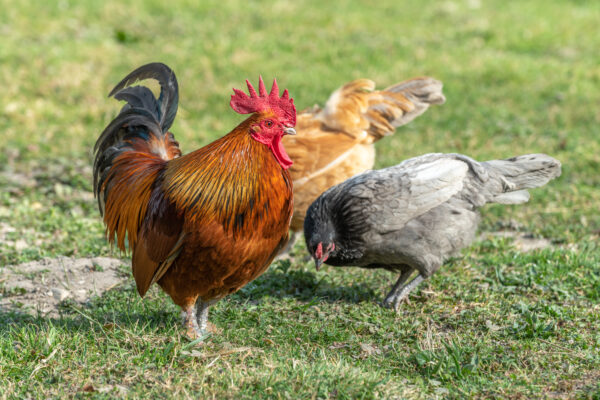
A rooster in the flock often serves as an additional source of protection for laying hens, a last defense if a predator gets past fences, walls and our watchful eyes. Not only do our boys ensure their girls know where to lay and what to eat, they also put themselves between the flock and peril, giving the hens a chance to run and hide while they fend off danger. Sometimes that jeopardy takes other form than carnivore. In extreme weather conditions, a rooster will often put his flock’s needs ahead of his own, ensuring that the mothers of future generations survive.
Such was the case during the recent oppressive U.S. heat wave that sent temperatures into the 100s, which put chickens in danger. I heard from friends in several regions whose roosters perished. Some let the hens drink all the available water. Others had the hens take relief in the only shade. Then I left for a family visit and returned to find that our beautiful Ameraucana, Barack (pictured above), had died the previous day, when the temperatures hovered around 110. While I grieved for our handsome boy, I also had to confront a larger problem: Our Ameraucana flock no longer had a rooster.
The girls’ safety was not my only concern. Ours is a breeding farm, and the loss of the rooster halted our breeding program. I quickly put the week’s eggs under two broody hens, hoping that at least a couple would result in chicks. Even if a few of the eggs proved fertile, it would be many months before a hatched cockerel would be ready to lead our flock. I needed to find a successor rooster quickly.
If your farm faces a similar crisis, consider taking one of these four steps to help you replace your rooster.
1. Merge Your Flocks Under One Rooster
If you have no qualms with combining your leaderless flock with another of your chicken groupings, merging the two flocks might be your best bet. The birds are accustomed to seeing each other, so establishing the pecking order will take less time than if a new bird were to be introduced. This also eliminates the need to quarantine additions to your flock. There are limitations to this option, mainly the size of your coop. If you want to keep your breeds separate, this is a temporary solution. Be vigilant about not hatching any eggs until a month after the birds are separated again.
2. Use a Spare Rooster
All our flocks have an alpha rooster and at least one “lieutenant,” or spare, just in case this very situation occurs. Barack was the lieutenant for our late Jefferson, who had died earlier this spring. We’d not yet had a chance to start raising a new spare boy. We do, however, have a surfeit of Orpington boys, with two or three for each flock. This would have been perfect if our layers’ safety were our only concern. Our spares already know us and how we manage our flocks. Integrating one of our Orpingtons into the Ameraucana flock would have provided the girls a protector accustomed to how our farm functions. Unfortunately for us, this would have been temporary. We need a purebred Ameraucana boy to sire purebred chicks. With an Orpington boy permanently in their midst, our hens would have produced Easter Egger chicks instead of Ameraucanas.
3. Check With a Poultry Club
Most regions have some sort of poultry club, whether it’s an informal flock owners’ group on social media or a structured 4-H chapter. Our club members frequently post about predator sightings, sales on chicken feed and extra egg cartons. They also often share photos of cockerels and roosters they want to sell or give away. Chances are, somebody in your local poultry club might have a boy of the proper age to lead a flock and, with luck, in the very breed you need.
4. Contact a Breeder
If you want to keep your chicks purebred, it’s best to ask a breeder whether he or she has a rooster or cockerel available. This also lets you refresh your birds’ bloodline, which is always a good idea after a few generations. Our particular problem with this, of course, is that we are the local breeder. Fortunately, we’ve grown a contact list of fellow breeders in Michigan and neighboring states. I swiftly contacted a breeder whose Ameraucana bloodlines have refreshed our flocks several times over the years. He did indeed have several blue and splash cockerels in his flock, but all were currently too young to lead a flock of their own. He has earmarked them for us so that, when autumn arrives, we’ll have an alpha and lieutenant who know each other and are ready to lead our girls.
For now, we are keeping tabs on our Amazon Ameraucanas. While the two broodies set their eggs, the others have stayed close to their coop instead of roaming around like usual. They seem to know they have no protector in their midst and are staying safe. We hope that by summer’s end they’ll have a new pair of guardians and we’ll be back in the Ameraucana chick business.




